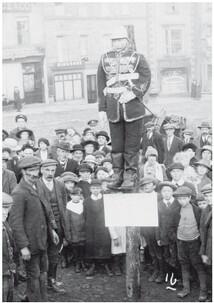Meeting the Enemy (53 page)
Authors: Richard van Emden

Cassel POW camp, November 1918: the parcel hut with all the records goes up in flames. There was suspicion among some POWs that comrades running the hut were taking items to sell to German guards.

March 1918: British prisoners remove the personal possessions of dead enemy soldiers killed in the opening days of the German spring offensive. A German soldier makes a note of the items retrieved.

A Red Cross boat carrying exchanged British POWs sails up the estuary towards Boston Harbour. The crowds on the riverbank cheer the arrival of the men. An hour earlier, the same civilians roundly booed German internees on their way home.

Dreaming of exchange: this humorous image obscures the fact that many men were suffering severe mental stress or ‘barbed wire disease’ after being cooped up for years.

Private Bill Easton, seated on the barrel, with his German friend Charley Feldner. Bill agreed to stay on behind enemy lines to help clear the wounded. Given his front-line experience, he was given the honorary rank of Acting Sergeant so that he could give orders to the Germans. On the extreme right stands Sub-Lieutenant Lindemann.

May 1918: the day after capture, Brigadier General Rees meets the Kaiser behind the Chemin des Dames battlefield. Rees recorded the event in his diary, noting how the Kaiser appeared reflective and downbeat.

November 1918: an effigy of the Kaiser is strung up in a British street. The public were assured that the Kaiser would be brought to justice but little diplomatic effort was expended in forcing the Dutch to hand over their ‘guest’. He remained in Holland until his death in 1941.

10 November 1918: the Kaiser quietly slips across the border into Holland. It was 24 hours since the verger of St George’s Church had watched him visit the neighbouring Hohenzollern Museum. As he left, he took a last look at the Church and then walked away into exile.

The Hohestrasse, Cologne, 1919: British and Empire soldiers walk amongst German civilians. The order not to fraternise was soon ignored by soldiers keen to enjoy the delights of an unspoilt urban metropolis after the devastated battlefields of the Somme and Ypres Salient.

British infantry pass German soldiers packing up to go home. The ‘pomp and polish order’ given to British troops ensured that Allied troops looked in near-immaculate condition as they crossed into Germany, bringing home to Germans the reality of defeat.

Tired German soldiers withdrawing through Cologne, cross over the river Rhine. Throughout the city banners exalting the courageous efforts of these men were raised by the nervous civilian population and then quickly taken down as Allied troops approached.

Men of the 23rd Royal Fusiliers pose for a picture with the German family on whom they were billeted. Despite complaints about ruined carpets and cigarette burns, most British soldiers got on remarkably well with the civilian population during the seven-year occupation of Cologne.
